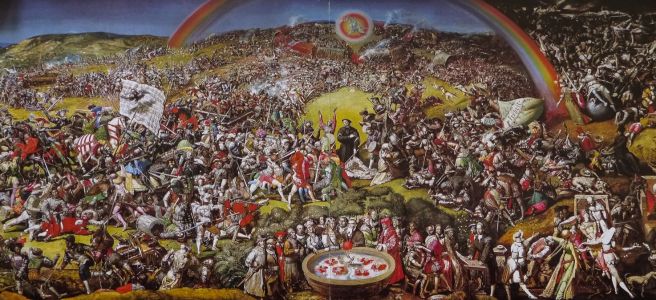As I wrote concerning stories of ships in the skies in medieval Ireland, “Just how to understand temporally and culturally distant narratives concerning anomalous aerial phenomena, let alone nonhuman entity encounters, is no simple matter.” The reasons for such stories and the ways they were communicated are more complicated than would appear offhand.
It’s such complexities that underwrite the difference of opinion between me and Rich Reynolds concerning just what to make of two broadsheets from the sixteenth century, one from Nuremberg (1561), the other from Basel (1566). I maintain they are what they purport to be, stories and artists’ impressions of aerial prodigies witnessed on specific dates and times of the day, Reynolds, that they “are ‘editorial rabble-rousing’ by the newspapers and ‘cartoonists’ (the guys who provided the drawings) about the ongoing societal consternations of Luther’s Reformation and the Catholic Church’s Counter-reformation.” My case, with links to our disputations, can be found here.
Exactly what was witnessed in 1561 and 1566 is a question that persists from those years to our own. My own stance concurs with the writer and illustrator of the Nuremberg broadsheet, Hans Glazer: “God alone knows.” Reynolds seems to be of the opinion that, in fact, nothing was seen, but he nowhere provides a explicit interpretation of the broadsheets themselves that would make clear just how he understands them, aside from their being “editorial rabble-rousing.” So, in the interests of intellectual balance, I want to attempt to argue here that the question as to whether the broadsheets refer to actually witnessed phenomena at all is indeterminate.
I must still disagree with Reynolds’ understanding. Pegging the broadsheets as “editorial rabble rousing” and their accompanying illustrations as “cartoons” is just too vague and ahistorical to do justice to the concrete facts of the print media of the time. The documents in question are best understood as examples of a popular genre of the day, that concerning prodigies and wonders. As Jerome Clark helpfully informs us: “Rediscovery of the prodigy book of Osequens in 1508 set off a flood of similar works. The most comprehensive was the Prodigiorum ac Ostentorum Chronicon of Conrad Lycosthenes, which appeared in 1557 at Basel” (48) [my emphasis]. But the appetite for such materials is not accidental.
Reynolds’ whole case is motivated by the historical context, the religious strife that raged through Europe with the Reformation (which begins in 1517) and Counter-Reformation (beginning with the Council of Trent, 1545-1563) culminating in the nightmarish carnage of the Thirty Years’ War (1618-1648). And, indeed, Glaser himself interprets what his text recounts and picture illustrates in religious terms, as “signs on the heaven, which are sent to us by the almighty God, to bring us to repentance”. The heightened religious fervour of the time, like at the turn of the millennium five centuries earlier, inspired an acutely heightened interest in supernatural signs and wonders. As Clark tells us, “Leading religious figures such as Martin Luther reaffirmed that signs must precede the end of the world, and Puritan belief fostered awareness of the supernatural by emphasis on a daily struggle between God and Satan in the worldly arena” (48). The historical context is analogous to that no less anxious one following the Second World War that, as Jung would have it, duly witnessed its own signs and wonders “seen in the sky”, flying saucers.
On the one hand, therefore, broadsheets, such as those from Nuremberg and Basel (both Protestant cities) could imaginably serve a propagandistic function. Disseminating accounts of “signs on the heaven” and “strange shapes in the sky” would affirm the populace’s belief in the momentousness of the times and the truth of their beliefs, as Glaser’s own gloss suggests. These reports, moreover, need not be true, but only seem to be true, bolstered by reference to specific times and places and witnesses and accompanied by artists’ impressions. The broadsheets, then, might be thought of as their days’ “fake news”.
On the other hand, however, the broadsheets do refer to specific locations, dates and times of day, which makes them easy enough for the skeptical to verify. Glaser’s broadsheet was printed a month after the events it claims to report; I have been unable to ascertain how long after the events of 27-28 July and 7 August the Basel pamphlet was printed. This is to say that the broadsheets could just as well be sincere reports of anomalous atmospheric phenomena, or not-so-anomalous phenomena (e.g., parhelia, a “blood moon”, etc.) interpreted through the eyes of the spirit of the day. In the final analysis, the question of “the truth” of these broadsheets turns on the question of just what status we grant the genre of print media of which they are an example.
So, either religious enthusiasm inspires visions of signs in the sky (how, exactly, is an interesting question…), which are duly reported by the broadsheets, which confirms and feeds this ferment, or the spiritual excitement sets up an expectation and desire for such wonders, which the broadsheets meet and maintain. In either case, the significance of these documents can be more or less ascertained only through a scrupulous attention to their own features and whatever can be discovered about their own communicative conventions in the context of their society and its concerns. Whether they are factual or fake, “God alone knows.” Nevertheless, and this is the most important point, however “obvious” their meaning might otherwise appear is a symptom of the invisibility of our own prejudices and ignorance.


One thought on ““Signs on the Heaven” and “strange shapes in the sky”: Giving the Devil his due”